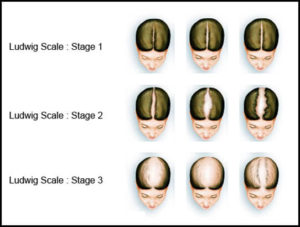Human hair grows in a continuous cyclic pattern of growth and rest known as the "hair growth cycle." Three phases of the cycle exist: Anagen= growth phase; Catagen= degradation phase; Telogen= resting phase.
Every day we lose around 50-100 strands of hair approximately, but then the same is replaced by new ones.This is called normal hairloss and does not need any treatment.
A lot of factors trigger hair loss, such as unhealthy lifestyle, stress, pollution, improper diet.
Here are some of the most common causes of Hair fall and Hair Thinning in Women:
- Poor diet
- Scalp infections
- Excessive usage of hair styling products
- Improper Hair Cosmetic Use/Improper Hair Care - Various chemical treatments on the hair
- Stress
- Family history of hair loss
- hormonal imbalance
- Levels of Endocrine Hormones -particularly androgens. During the time that hormonal changes caused by menopause take place, the levels of androgens rise and many women find that their hair has thinned.
Female Pattern Hair Loss (FPHL)
Female Pattern Hair Loss (FPHL) is a form of androgenetic alopecia with a multi-factorial, genetically determined trait. Both androgen-dependent and androgen-independent mechanisms plus a biologically normal aging process is involved. Female and male members of the family may both be affected.
Majority has normal type II 5-α reductase levels and normal DHT level in scalp skin. Elevated androgen level were seen in 16% of women with hair loss alone, and 79% if associated with hirsutism or menstrual disturbance.
There are 3 major patterns in female Pattern Hair Loss:
1. M-Shaped or high forehead - Norwood's Classification
2. Thinning at the centerline, extending sidway - Ludqig's or Centrifugal Classification
3. Christmas Tree Pattern - Olsen's Classification
Type 1: Norwood's Classification
• Born with a high forehead or M-shaped hairline
• Thinning of the hairline and the crown similar to men with aging
• Classification is by the Norwood System similar to men
Type 2. Ludwig's Classification
• Central and possibly lateral thinning with sparing of the hairline
• Classification is by the Ludwig System
Type 3. Olsen's Classification
- Accentuation of frontal Loss breaching the frontal hairline
• The loss is widest in front tapering towards the crown
• Classification is by the Olsen's System
Diffuse Hair Loss in Women
Telogen effluvium (TE) is the most common cause of diffuse hair loss in adult females.
Abrupt, rapid, generalized shedding of normal club hairs, 2-3 months after a triggering event like parturition, high fever, major surgery, etc. indicates TE, while gradual diffuse hair loss with thinning of central scalp/widening of central parting line/frontotemporal recession indicates FPHL (Female Pattern Hairloss).
Chronic telogen effluvium (CTE)
Excessive, alarming diffuse shedding coming from a normal looking head with plenty of hairs and without an obvious cause is the hallmark of CTE.
What is the approach To manage Hair Loss In women
Evaluation of patient's hair problem by examining the scalp and hair and investigations like Trichoscopy and other blood investigations if necessary.
Complete blood count and routine urine examination, levels of serum ferritin and T3, T4, and TSH should be checked in all cases of diffuse hair loss without a discernable cause, as iron deficiency and thyroid hormone disorders are the two common conditions often associated with diffuse hair loss.
It's important to find the cause and whether or not the problem will respond to medical treatment .
Treatment Options available
- Telogen Effluvium (TE) is self limited and resolves in 3-6 months if the trigger is removed or treated
- The prognosis of Chronic Telogen Effluvium (CTE) is less certain and may take 3-10 years for spontaneous resolution.
- Topical minoxidil & Finesteride.
- Platelet Rich Plasma (PRP) Therapy
- Growth Factor/Stem cell injections
- Hair Surgery


